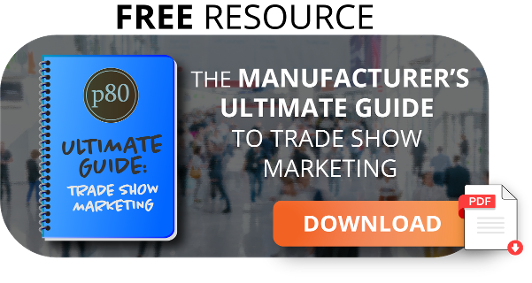Inbound Marketing Blog
for Manufacturers and Healthcare Companies
Manufacturing Trade Show Ideas for Making the Perfect Follow-Up Email
 In a world that seems to be endlessly moving toward digital, manufacturers know that there's still a shred or two of value in old-fashioned face-to-face relationship building. In your world, a real handshake still means something.
In a world that seems to be endlessly moving toward digital, manufacturers know that there's still a shred or two of value in old-fashioned face-to-face relationship building. In your world, a real handshake still means something.
So, you've done the hard part and put your trade show ideas to work. You left your comfort zone and made your booth exciting, your swag went beyond branded pens, and maybe you even had a party beforehand to drum up excitement. Now you've got a fish bowl full of business cards for your efforts.
What's next? Following up that in-person connection with some digital marketing.
Trade Show Ideas for Email: The Morning After
Before you dig into your follow-up email, remember the inbound marketing basics. Rest assured that your fresh new leads already know you're selling something, so there's no need to remind them right away. Instead, this moment is to let your new contacts know that you were paying attention when you talked and that you'd like to establish a genuine relationship with them. Focus on being helpful and building rapport.
Using email templates for your follow-up emails can help you get started, but stay away from bulk messaging. Remember, you're trying to establish a personal relationship that began with face-to-face contact. The majority of your message can be the same from person to person, but try to include something unique for each prospect.
For example, if you have a photo of the contact from the event, include it! Or, if you made notes about specific questions or remember a story told to you, mention them in the message. Even the smallest details you have -- “Hey! How could I forget the guy with the lime green tie!?” -- will help your message stand out from the other potential follow-ups from the trade show. Save the bulk messages for announcing contest winners, setting the stage for the next event, and similarly general information.
What to Include in Your Follow-Up Emails
First, wait a day or two (but never more than a week!) before sending your message. Your contacts might still be attending events, traveling, or catching up with urgent matters at home right after a trade show. You can, of course, get your messages ready to go while your mind is fresh and schedule them for later. Here are a few ideas for what to include:
1. A Quick Recap
If you spent time speaking to the contact, you should have some insight into that person’s problems. So, add something like, "Thanks for talking with me about your trouble finding [the perfect solution]. It can be tough to overcome [struggle]." Then point to some helpful blog posts or other content to get the ball rolling.
Remember, the recap is about the recipient, not you!
2. Free Content
From e-books to white papers to case studies, information-packed content that's geared toward the contact's industry and needs will be well received. It doesn't go straight for the sale, yet still points toward your goals.
3. Ask for Questions
To help keep the conversation going, ask the contact if he has any questions about the industry or your particular niche that you can help answer.
4. More Connections
Don't go overboard on the links in your messages or they'll start to compete with each other for attention.
However, if you're struggling for content to include because the connection was loose or too brief during the trade show, offer your social media accounts or a signup to your newsletter to help the lead learn more and stay connected.
Building Relationships
As you work on your follow-up emails, remember that you're working on establishing lasting partnerships and not making short-term sales. When you focus on being helpful and informative, you'll be working on building a base of customers that will boost your long-term numbers, and that's better than any single sale you might nab.
Our Blogs, Direct to Your Inbox!
How to Audit your Online Marketing
If you are executing digital marketing, congratulations! You are most likely already one step ahead of your competition, and making strides to meaningfully connect with prospects online. But, how do you know if you’re seeing continual success year over year, and improving your metrics?
Without the tools in place to analyze and benchmark your efforts, it is impossible to scale your online marketing and ensure continuous success.

